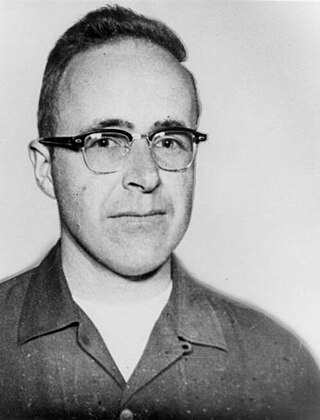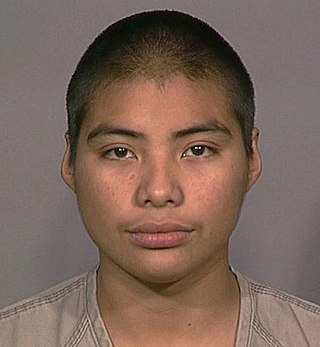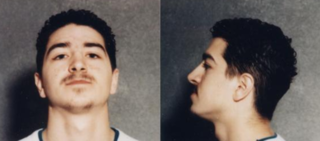
The Chicago Outfit is an Italian-American Mafia crime family based in Chicago, Illinois, which originated in the city's South Side in 1910. The organization is part of the larger Italian-American Mafia.

Joseph Corbett Jr. was an American fugitive, murderer, and prison escapee who, in 1960, was placed on the FBI's 10 most wanted list after kidnapping and murdering Adolph Coors III, heir to the Coors beer fortune.

In the 1960s, for a second decade, the United States FBI continued to maintain a public list of the people it regarded as the Ten Most Wanted Fugitives. Following is a brief review of FBI people and events that place the 1960s decade in context, and then an historical list of individual suspects whose names first appeared on the 10 Most Wanted list during the decade of the 1960s, under FBI Director J. Edgar Hoover.

In 1952, the United States FBI, under Director J. Edgar Hoover, continued for a third year to maintain a public list of the people it regarded as the Ten Most Wanted Fugitives.

In 1969, the United States FBI, under Director J. Edgar Hoover, continued for a twentieth year to maintain a public list of the people it regarded as the Ten Most Wanted Fugitives.

Jason Derek Brown is an American fugitive wanted for first degree murder and armed robbery in Phoenix, Arizona. On November 29, 2004, Brown allegedly shot and killed Robert Keith Palomares, a 24-year-old armored car guard outside a movie theater and then fled with the money. On December 8, 2007, he was named by the FBI as the 489th fugitive to be placed on its Ten Most Wanted list. He is considered to be armed and extremely dangerous. On September 7, 2022, he was removed from the Ten Most Wanted list without being captured, but he is still wanted. He was replaced on the list by Michael James Pratt. In 2022, a theatrical film about Brown's life was made, titled American Murderer, starring Tom Pelphrey as Brown, Ryan Phillippe, Idina Menzel, and Jacki Weaver.
Jay Anthony "Jaybird" Dobyns is a retired Special Agent and veteran undercover operative with the United States Bureau of Alcohol, Tobacco, Firearms and Explosives (ATF), author, public speaker, high school football coach, and University of Arizona adjunct professor.
Herbert "Fat Herbie" Blitzstein was an American mobster who was a loanshark, bookmaker, racketeer and lieutenant to Tony "The Ant" Spilotro and the Chicago Outfit in Las Vegas, Nevada.

In the United States, a common definition of terrorism is the systematic or threatened use of violence in order to create a general climate of fear to intimidate a population or government and thereby effect political, religious, or ideological change. This article serves as a list and a compilation of acts of terrorism, attempts to commit acts of terrorism, and other such items which pertain to terrorist activities which are engaged in by non-state actors or spies who are acting in the interests of state actors or persons who are acting without the approval of foreign governments within the domestic borders of the United States.

Jared Lee Loughner is an American mass murderer who pled guilty to 19 charges of murder and attempted murder in connection with the January 8, 2011, Tucson shooting, in which he shot and severely injured U.S. Representative Gabby Giffords, and killed six people, including Chief U.S. District Court Judge John Roll, Gabe Zimmerman, a member of Giffords's staff, and a 9-year-old girl, Christina-Taylor Green. Loughner shot and injured a total of 13 people, including one man who was injured while subduing him.

The FBI's Ten Most Wanted Fugitives during the 2010s is a list, maintained for a seventh decade, of the Ten Most Wanted Fugitives of the United States Federal Bureau of Investigation. At any given time, the FBI is actively searching for 12,000 fugitives. During the 2010s, 29 new fugitives were added to the list. By the close of the decade a total of 523 fugitives had been listed on the Top Ten list, of whom 488 have been captured or located.
Paddock is an English surname. Notable people with the surname include:

On October 1, 2017, a mass shooting occurred when 64-year-old Stephen Paddock opened fire on the crowd attending the Route 91 Harvest music festival on the Las Vegas Strip in Nevada from his 32nd-floor suites in the Mandalay Bay hotel. He fired more than 1,000 rounds, killing 60 people and wounding at least 413. The ensuing panic brought the total number of injured to approximately 867. About an hour later, he was found dead in his room from a self-inflicted gunshot wound. The motive for the shooting is officially undetermined.

Route 91 Harvest was a country music festival in the United States that was held annually in Paradise, Nevada, from 2014 to 2017 in the Las Vegas Village, a 15-acre (6.1 ha) lot on Las Vegas Boulevard, directly across from the Luxor Las Vegas hotel and casino and diagonally across from the Mandalay Bay resort and casino. The festival's promoters were Live Nation Entertainment and MGM Resorts International.

Stephen Craig Paddock was an American mass murderer who perpetrated the 2017 Las Vegas shooting. Paddock opened fire into a crowd of about 22,000 concertgoers attending a country music festival on the Las Vegas Strip, killing 60 people and injuring approximately 867. Paddock killed himself in his hotel room following the shooting. The incident is the deadliest mass shooting by a lone shooter in United States history. Paddock's motive remains officially undetermined, and the possible factors are the subject of speculation.

Santiago "Pucho" Villalba Mederos is an American former fugitive who was added to the FBI Ten Most Wanted Fugitives list on September 25, 2017. He was wanted for two murders in Tacoma, Washington, in 2010. Mederos was the 515th fugitive to be placed on the FBI's Ten Most Wanted Fugitives list. The FBI offered a reward of up to $100,000 for information leading to his capture. He was captured in Tenancingo, Mexico, on June 5, 2020.

Anthony "Tony" Ray Amati, known as The Thrill Killer, is an American serial killer who shot and killed three people in Las Vegas, Nevada, from May to August 1996. The FBI was brought in to find Amati's whereabouts and added him to the FBI's ten most wanted list on February 27, 1998. He was arrested two days later, was tried, found guilty, and sentenced to life imprisonment with a minimum of 40 years served in 1999.

There are some conspiracy theories about the 2017 Las Vegas shooting, the deadliest mass shooting by one gunman in American history. These hypotheses offer alternate explanations to the official version of the incident, including speculation about the involvement of shooters other than the identified perpetrator, Stephen Paddock.












